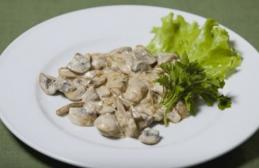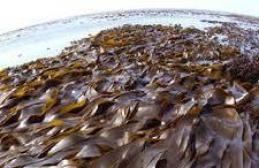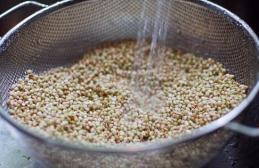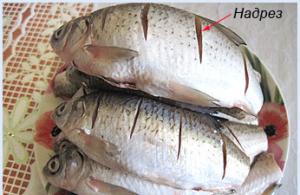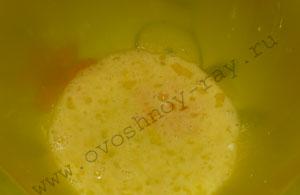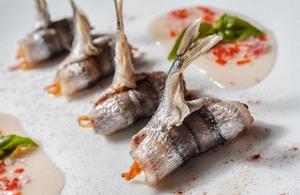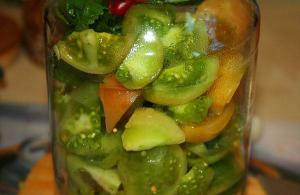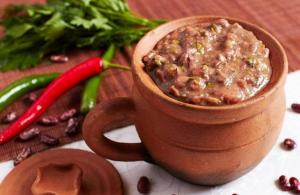French Bechamel sauce (from French " white sauce") - classic European cuisine. This base sauce, on the basis of which soufflé, lasagna and other sauces are subsequently prepared. The main ingredients are milk, flour, fat. Bechamel sauce is very easy to make at home.
Classic recipe for making Bechamel sauce at home
This recipe is a base that you can experiment with by adding different ingredients.
So, what do we need to prepare the classic version?
- butter – 50 g;
- vegetable oil (preferably sunflower) – 2 tbsp. spoons;
- wheat flour – 2 tbsp. spoons;
- milk of any fat content – 0.75 l;
- a little salt.
How to make Bechamel sauce?
Below is step-by-step instruction. Follow it exactly and you will get a real French sauce.
- Melt two types of butter in a saucepan or ladle and stir.
- Begin to gradually stir flour into the saucepan with butter, avoiding lumps.
- Add milk a little at a time, stirring constantly. Bring to a boil.
- Then add a little salt and cook over low heat, stirring constantly.
- The cooking process will take up to 10 minutes.
Depending on the consistency you want the sauce, the cooking time will also depend. If liquid is required, add a little more milk. If it is thick, evaporate until desired. Bechamel can be served immediately. Keep refrigerated.
Lasagna sauce recipe



This sauce is very often used for baking. Lasagna is a dish that cannot be imagined without white French sauce. Housewives usually choose classic recipe Bechamel sauce for lasagna to get a “French touch” of flavor in the dish.
Grocery list:
- flour highest quality– tablespoon;
- yolk chicken egg- 2 pcs.;
- capers up to 10 pcs.;
- butter or spread – 50 g;
- broth (if you want to reduce the calorie content of the dish, then use vegetable broth) – 280 ml;
- a little salt and pepper.
How to cook?
- Fry the butter and flour a little in a saucepan.
- Pour the broth into the butter-flour mixture and simmer until the sauce thickens.
- Add salt and pepper to taste.
- Just before the end of cooking, add chicken yolks, stir and heat over low heat for another 2 minutes.
- For added spice, add in ready sauce chopped capers. It is this additive that will reveal the taste of vegetable lasagna.
Those who don’t really like capers replace them with pickles.
Muscat Bechamel sauce

Nutmeg gives the sauce a spicy note that will appeal to connoisseurs original combinations and bright tastes.
So, what do you need to prepare a spicy sauce?
- flour 65 g (1/4 cup);
- butter 4 tbsp;
- half a liter of milk;
- a little salt;
- a pinch of white pepper;
- also a pinch of ground nutmeg.
Instructions:
- Melt the butter in a saucepan.
- Pour flour into a container with butter and stir with a wooden spoon until the flour begins to change color. This is no more than 2 minutes in time.
- Add the milk a little at a time, stirring the lumps. Stir constantly until the mixture becomes homogeneous.
- Stir the sauce all the time over low heat. As soon as it starts to thicken, add nutmeg and other spices.
The flavorful sauce is ready!
Bechamel meat sauce recipe
This type of sauce is used to prepare meat paste or cannelloni.
What products should I take?
- mixture of pork and ground beef(optional, but preferably this kind of minced meat) - 70 g;
- flour - 2 tablespoons;
- milk – 300 ml;
- regular onion - ¼ head;
- butter – 30 g;
- parsley and celery root (chopped).
Recipe step by step:
- In a saucepan or other container with non-stick coating Combine milk and onion (do not cut).
- Boil over low heat for 15 minutes and remove the onion from the milk.
- Meanwhile, melt the butter in a separate container and add flour to it.
- Heat over low heat for 4 minutes, stirring constantly, until the flour is golden brown.
- After cooling, add milk to the flour and butter mixture.
- Put on fire, stir constantly and cook for up to 10 minutes. Do not bring it to a boil.
- Once the sauce becomes thick, strain it through a strainer and add spices.
- Separately, saute the minced meat and parsley roots with celery in a frying pan.
- Add the meat to the main sauce and simmer for another 10 minutes.
After preparing the sauce, you can immediately season the main dish.
Sauce with added cheese

Ingredients:
- milk – 1 glass;
- flour (preferably wheat) – 1.5 tbsp;
- regular onion - 1 small;
- oil – 30 g;
- broth (vegetable or meat) – 0.5 tbsp.;
- grated cheese – 3 tbsp;
- spices to choose from.
Instructions:
- Melt the butter in a non-stick frying pan, add flour and fry until golden brown.
- Add chopped onion, fry a little more and start pouring in milk. Let it boil and let cool a little.
- Rub the resulting mixture through a sieve.
- Pour the pre-prepared broth into the grated mixture. If you don’t have any broth at home, you can add milk or just water. Boil.
- After boiling, add hard cheese and mix thoroughly.
- Cook until the desired consistency and the cheese is completely dissolved.
- After that, add your favorite spices, cook for no more than 10 minutes, and let the sauce brew.
This sauce is suitable as a dressing for meat or for baking vegetables. Flour - as much as butter;
Cooking method:
- Peel the mushrooms, wash and cut into small pieces.
- Melt the butter in a saucepan and add flour to it. Fry until golden brown. This will take 1-2 minutes. Stir constantly!
- Keeping the mixture over medium heat, begin adding 1.5 cups of milk, stirring constantly until the lumps dissolve.
- Stir the yolks in the remaining milk and pour into the main mixture.
- Then add the broth and the remaining 0.5 cups of milk to the sauce.
- Cook over low heat until boiling, stirring constantly.
- When the sauce reaches the desired consistency, add the mushrooms and simmer for another 15 minutes.
- At the end, add a spoonful of butter and the sauce is ready!
Bechamel sauce or white sauce is perhaps one of the most famous French sauces. It perfectly performs all the functions of the sauce: improves taste and appearance dishes, increases its juiciness and nutritional value. Béchamel is one of the five main sauces of classic French cuisine. It goes well with almost all hot dishes of meat, poultry, fish, eggs and vegetables.
The basic recipe for bechamel sauce is simple, like everything ingenious: fry an equal amount butter and flour, pour hot milk. It might seem like nothing special, but you can tell a lot about this sauce.
As is often the case with French recipes, the roots of béchamel sauce come from  antiquity. Even at the beginning of our era, cooks thickened sauces wheat flour and added honey and many herbs and spices. The recipe for floury white sauce has been preserved in the cuisines of France, Italy, Greece and some other countries.
antiquity. Even at the beginning of our era, cooks thickened sauces wheat flour and added honey and many herbs and spices. The recipe for floury white sauce has been preserved in the cuisines of France, Italy, Greece and some other countries.
There is still debate about who invented bechamel and when. According to the official version, the sauce is named after Louis de Bechamel, Marquis de Nointel (1630-1703), the famous financier of the 17th century and manager in the kitchen of Louis XIV. According to legend, the Marquis added cream to the veal veloute sauce in an attempt to come up with a worthy accompaniment for dried cod. However, there is no evidence that he was a cook or gourmet and experimented with dishes. Moreover, the bechamel sauce was  known long before his birth. Perhaps the creator of the sauce was his contemporary - Pierre de la Varenne, chef of Louis XIV. As a sign of gratitude for something, he named his creation after Louis de Béchamel.
known long before his birth. Perhaps the creator of the sauce was his contemporary - Pierre de la Varenne, chef of Louis XIV. As a sign of gratitude for something, he named his creation after Louis de Béchamel.
Another version claims that béchamel sauce appeared in France thanks to Catherine de Medici (1519-1589), the wife of Henry II. In 1533, she came to France from her native Italy with her chefs and pasta makers. This event enriched the palace cuisine of France with traditional Italian dishes, among which was bechamel sauce. This version is supported by the fact that in Italian a white sauce made from flour, butter and milk with parmesan, white pepper and nutmeg is called balsamella (Balsamella, Besciamella). In Italy, lasagna, cannelloni, and vegetable gratins have been prepared with it since ancient times.
Be that as it may, the dawn of the popularity of bechamel sauce came in the 17th century, when  numerous experimenters decorated it with wines, vegetables, bacon, spices, chicken and partridge broths, strained it several times and steamed it in the oven. The unification of the recipe occurred in the 18th century, during the dominance of royal kitchen Antonina Karema. It was he who removed everything unnecessary and created a classic recipe for a rich white sauce, which, in addition to the butter-flour mixture, included cream and yolks. His follower Auguste Escoffier removed eggs from the recipe, but used meat, which was closer to veloute sauce.
numerous experimenters decorated it with wines, vegetables, bacon, spices, chicken and partridge broths, strained it several times and steamed it in the oven. The unification of the recipe occurred in the 18th century, during the dominance of royal kitchen Antonina Karema. It was he who removed everything unnecessary and created a classic recipe for a rich white sauce, which, in addition to the butter-flour mixture, included cream and yolks. His follower Auguste Escoffier removed eggs from the recipe, but used meat, which was closer to veloute sauce.
Bechamel is classified as a basic white sauce, which means it can be used in a variety of various sauces, for example these:
 . Mornay - bechamel with the addition of grated cheese, usually Parmesan and Gruyère, but emmental and cheddar can also be added. Escoffier recommends adding mornay fish broth. Mornay is served with seafood and vegetables. It makes a Hot Brown sandwich ( open sandwich with turkey and bacon, topped with sauce).
. Mornay - bechamel with the addition of grated cheese, usually Parmesan and Gruyère, but emmental and cheddar can also be added. Escoffier recommends adding mornay fish broth. Mornay is served with seafood and vegetables. It makes a Hot Brown sandwich ( open sandwich with turkey and bacon, topped with sauce).
. Nantua - bechamel with cream and crab oil. Served with seafood.
. Soubise - bechamel with the addition of onion puree. Served with fish, meat, poultry, vegetables.
Bechamel sauce recipes
Bechamel by Auguste Escoffier
Auguste Escoffier - king of chefs and cook of kings, creator of the "Culinary Guide" -  the real bible French cooking end of the 19th century. All his recipes are designed for restaurant cuisine, so don’t be surprised by the number of ingredients and complexity of execution. The result will be worthy of a royal table.
the real bible French cooking end of the 19th century. All his recipes are designed for restaurant cuisine, so don’t be surprised by the number of ingredients and complexity of execution. The result will be worthy of a royal table.
Ingredients (for 5 liters of sauce):
650 g flour gravy (350 g sifted flour, fried in 300 g butter),
5 liters of boiled milk,
300g lean veal, stewed in butter with 2 thinly sliced onions, a sprig of thyme, a pinch of pepper, a little nutmeg and 25g salt.
Preparation:
Mix flour gravy with hot milk, bring to a boil, stirring. Add veal stew, cut into cubes. Boil for an hour, strain through a cloth. To store, cover the surface of the sauce with a thin layer of melted butter.  Quick method: Add meat, onion, thyme, pepper and nutmeg to boiling milk, cover with a lid and place near the fire for 10 minutes. Then mix this milk with flour gravy, bring to a boil and simmer for 15-20 minutes.
Quick method: Add meat, onion, thyme, pepper and nutmeg to boiling milk, cover with a lid and place near the fire for 10 minutes. Then mix this milk with flour gravy, bring to a boil and simmer for 15-20 minutes.
Escoffier also explains how you can make a creamy sauce from béchamel sauce: add a little cream, put on high heat and reduce by a quarter, stirring constantly. Strain, add more fresh heavy cream and lemon juice.
The authors of the “Book about Tasty and healthy food" True, there it is simply called - white sauce for boiled rabbit, veal, lamb and chicken.
White sauce 
Ingredients:
1 tbsp. flour,
2 tbsp. butter,
1.5 cups broth,
1 yolk.
Preparation:
Lightly fry the flour with the same amount of butter, dilute with the strained broth obtained from cooking the meat, and cook over low heat for 5-10 minutes. Remove the sauce from the heat, add the yolk mixed with a small amount of sauce, add salt and the remaining butter to taste, stir.
For meatballs, cutlets, liver and fried game, “The Book of Tasty and Healthy Food” recommends preparing another sauce, also similar to bechamel - sour cream.
 Sour cream sauce
Sour cream sauce
Ingredients:
1 tbsp. flour,
1 tbsp. oils,
0.5 cups sour cream,
1 glass of meat broth.
Preparation:
Fry the flour in oil, dilute with broth or vegetable broth, add sour cream and cook over low heat for 5-10 minutes. Add salt to taste. You can diversify sour cream sauce fried onions added at the end of cooking.
In modern cookbooks Bechamel usually appears as a mixture of these two sauces - white and sour cream.
Modern bechamel 
Ingredients:
2 cups milk (can be replaced with 1.5 cups meat or fish broth and 0.5 cup sour cream),
3 tbsp. butter,
3 tbsp. flour,
salt, allspice, nutmeg to taste.
 Preparation:
Preparation:
Fry the sifted flour in heated butter until creamy and dilute it with hot milk or broth, stirring thoroughly. Bring the mixture to a boil and cook for 15-20 minutes until the sauce thickens. Season bechamel cooked with broth with sour cream. Add salt and spices to the finished sauce, boil and strain.
Based on this sauce you can prepare French sauce. For this you will need champignons and even more butter. Salt the finely chopped mushrooms and fry in oil until the liquid evaporates. Pour in the bechamel sauce, stir and bring to a boil.
How can you use all this splendor? We offer several original recipes with bechamel sauce:
Recipes with bechamel sauce 
Croque Monsieur and Croque Madame
Behind these extravagant names are French hot ham and egg sandwiches. The preparation of the dish is very simple, but these are not banal sandwiches, but real French cuisine.
Croque-monsieur: brush pieces of bread with sauce, place ham and cheese between them, bake in the oven for 10-12 minutes.
Croque Madame: Same thing, but top with a fried egg.

Ingredients:
1 head of cauliflower,
50 g flour,
50 g butter,
500 ml milk,
1 egg,
salt, spices to taste.
Preparation:
Steam the whole cabbage, cool, and separate into inflorescences. Melt a little, fry the flour, pour in hot milk, stir until smooth and boil for a few minutes. Add beaten egg, salt and spices. Grease a baking dish with butter, pour in a little sauce, lay out a layer of cabbage, and pour in the remaining sauce. Bake for 35-40 minutes at 200ºС. When the top begins to yellow, cover the pan with a lid or foil. Cool the finished dish and turn it over onto a plate. It will keep its shape.

Ingredients:
1 kg eggplants,
1 kg potatoes,
100 g hard cheese,
1 kg mixed minced meat,
300 g tomatoes,
100 ml white wine,
2 onions,
100 ml olive oil,
2 cloves of garlic,
200-300 ml bechamel sauce,
cinnamon, cloves, parsley, pepper, salt - to taste.
Preparation:
Cut the eggplants and potatoes into slices and fry until golden crust. (To make the dish lighter, you can bake eggplants and potatoes.) Fry the minced meat along with finely chopped onion, pour in wine, add salt, spices and simmer for 10-15 minutes. Add crushed garlic, chopped tomatoes and simmer until the sauce thickens.
Assembling the moussaka: place a layer of potatoes in a greased form, add salt, sprinkle with cheese and herbs. Next - layer minced meat and a layer of eggplant. Sprinkle the remaining cheese and herbs on top, pour over the bechamel sauce. Bake the moussaka for 20-25 minutes at 200ºC. Cut and serve the dish slightly cooled.
 How did it happen that in Russia bechamel is confused with its very distant relative- mayonnaise. Bechamel and mayonnaise - ancient sauces in world cuisine. They have absolutely different composition And different areas applications, despite the similar appearance and the same goals: soften the consistency, add fat and juiciness to the dish. In the cuisine of France and Italy, the zones of influence of these sauces are clearly divided: bechamel is used in hot dishes, and mayonnaise in cold dishes. Unfortunately, bechamel is rarely found on the tables of modern Russians, completely replaced by mayonnaise. This is a grave mistake. In fact, mayonnaise is cold sauce, suitable only in salads. Bake, stew and fry in mayonnaise, add it to hot soup- this is not only bad form, but also harmful to health.
How did it happen that in Russia bechamel is confused with its very distant relative- mayonnaise. Bechamel and mayonnaise - ancient sauces in world cuisine. They have absolutely different composition And different areas applications, despite the similar appearance and the same goals: soften the consistency, add fat and juiciness to the dish. In the cuisine of France and Italy, the zones of influence of these sauces are clearly divided: bechamel is used in hot dishes, and mayonnaise in cold dishes. Unfortunately, bechamel is rarely found on the tables of modern Russians, completely replaced by mayonnaise. This is a grave mistake. In fact, mayonnaise is cold sauce, suitable only in salads. Bake, stew and fry in mayonnaise, add it to hot soup- this is not only bad form, but also harmful to health.
If you love French meat, bake potatoes with mayonnaise, or stew fish and rabbit in mayonnaise, try changing your habits a little and making a sauce specially designed for this purpose - bechamel. It is ideal for hot dishes: it does not break down into components and gently envelops every piece. As for taste, bechamel sauce, unlike mayonnaise, does not have a pronounced chemical taste and allows various options: It can be made creamy, tangy, sour, spicy and even sweet. And all this is simple natural ingredients, without emulsifiers and dyes.
Happy experimenting and bon appetit!
In general, béchamel is a classic French sauce made from a flour dressing called roux and milk.
Most likely, the sauce appeared as a result of alteration of some kind old recipe, and one of the royal chefs dedicated it to the nobleman - Marquis Louis de Beshameil - head waiter of Louis XIV. Louis de Béchamel was known as an excellent gourmet and an enlightened lover of the arts. According to one legend, the old Count Descart was even indignant about this: “Well, this Bechamel is lucky: with this white sauce, poultry meat was served at my table 20 years before he was born, but for some reason the sauce was not named after me !
It's not really classic version. From original recipe I backed off by replacing the milk with cream and adding lemon juice.
Necessary:
1 tbsp. spoon of flour
1 tbsp. spoon of butter
200-300 ml cream (10%)
a pinch of salt
a pinch of ground nutmeg
1/4 lemon
Cooking time: 10 minutes.
Combine butter and flour in a saucepan. Stirring constantly, fry over medium heat for about 1 minute. The mixture should not darken.


Slowly, in a thin stream pour in the cream. Stir to avoid the formation of lumps. However, if the flour still clumps, use a mixer or blender to get rid of them. If you don't have a mixer or blender at hand, try whisking the sauce a little with a whisk or fork, or straining it through a sieve.

At the very end of cooking, add salt, a pinch of nutmeg and a little freshly ground pepper to the sauce. It is best to use white or pink pepper - they are not as sharp as black, but they will add their own note.

I stir vigorously)

Remove the sauce from the heat and squeeze in the lemon juice. It wouldn’t hurt to add finely grated zest here too.

The sauce can be served warm or cold.
This is what lasagna is made with. Sheets of pasta are sandwiched with a sauce made from tomatoes, minced meat and bechamel sauce. In combination with mozzarella and parmesan, you get an almost canonical version (practically, because only, probably, a true Italian, at least the third generation, can cook truly traditional classics Italian cuisine).
Béchamel sauce is one of the basic, mother sauces of French cuisine, which has quite rightly won worldwide recognition and love. Bechamel is the king of white sauces and the ancestor of many other, more complex sauces.
There are several legends about the creation of this sauce, but personally, the most plausible version seems to me to be the one that says that béchamel sauce was created by the court cook of Louis XIV, François de la Varenne, as a compliment to the king’s chamberlain, Louis de Béchamel.
I also heard a similar, broader version of the creation of the sauce, with the participation of Monsieur Bechamel, when for one of the magnificent receptions of King Louis XIV they simply did not have time to prepare for the planned fish dishes required quantity popular in French cuisine, and the court cooks (under the leadership of Francois de la Varenne) used hot milk instead of broth, diluting it with a culinary thickener -. And Monsieur Bechamel, as the chief court chamberlain (a sort of supply manager, including acting as a kitchen storekeeper), took the blame for the untimely organization necessary products in sufficient quantities, which, by the way, threatened severe punishment. However, the table was served perfectly new sauce, which was to the taste of the guests, became widespread, went down in history and took its rightful place in world cuisine.
Famous French and béchamel sauce, like the two main white sauces of French cuisine, are practically twin brothers, since they are prepared on the basis with addition in the first case and hot milk in the second, while the proportions of the mixture of roux and liquid, as well as the principles of preparation, remain approximately the same.
There are numerous interpretations and variations of the preparation of bechamel sauce, for example, without using a roux mixture (then the sauce is enriched with cream and beurre manier paste) and quick versions, where the sauce is prepared according to the “all at once” principle, when the recipe skips the steps of preparing the roux mixture and introducing milk to it.
I suggest you consider the classic basic recipe for preparing bechamel sauce, having mastered it, in the future you will be able to decide on the advisability of using one or another recipe for preparing the sauce that differs from the basic one.
So, the classic thick white bechamel sauce is prepared using a mixture of roux with the addition of hot milk in a ratio of approximately 1 to 5.
To prepare 1 liter of sauce you will need:
- roux mixture – 180-200 grams;
- whole milk – 1 liter;
- large onion - 1 piece;
- carnation, Bay leaf;
- salt, pepper, nutmeg - to taste.
In all classic recipes The essential ingredients of bechamel sauce are a large onion, several sprigs of cloves, bay leaf and nutmeg. Their use is really advisable because it makes the sauce taste deep, moderately spicy. You can omit the use of spices if their taste would be inappropriate in the dish that will be prepared on the basis of the sauce or to which bechamel will be served separately.

Pour the milk into a saucepan and add the onions and spices except the nutmeg. Bring the contents of the pan to a boil and cook at a gentle bubbly boil for 7-10 minutes. Be careful not to let the milk run away. Then cover the saucepan with a lid and set aside to cool slightly.

While the milk is cooling, in a separate saucepan prepare a white butter-flour roux mixture from butter and flour taken in equal parts: for 200 grams of roux mixture you will need 100 grams of butter and 100 grams of flour. It is important to prepare a white roux so that the color of the future sauce is as noble as possible.
Cool the finished roux slightly and put a couple of tablespoons of the mixture in a separate bowl. This a small amount of The roux may be needed during the final stages of cooking if the sauce turns out too thin.
In a separate article you can read in detail about preparation

When the roux mixture is ready, pour in the strained hot mixture. spiced milk. Start quickly and thoroughly stirring the contents of the pan with a whisk and cook over medium heat for 4-5 minutes until the sauce begins to boil. Now you can reduce the heat to the lowest setting and cook the sauce at a low bubbly boil for about 20-25 minutes.
When the sauce becomes smooth and glossy, season it with salt to taste, ground white pepper and, of course, a pinch of ground nutmeg.

Cook bechamel sauce to one of three states: liquid, medium or thick. Each of these consistencies will be correct and depends on how you intend to use the sauce in the future.
Thin bechamel is ideal for a light coating on vegetables, fish, meat, poultry, as well as for adding thickness to some soups.
In this case, the sauce will have the fluidity of low-fat cream and almost immediately flow from the spatula in a thin, thin ribbon.

Bechamel medium thickness also used to coat vegetables before baking, various gratins and casseroles.
The consistency of the medium-thick sauce is determined by the way it flows from the spatula in a wide ribbon. The sauce evenly covers the spatula, holds well on it, but at the same time retains its fluidity.

Thick bechamel is used, as a rule, to bind ingredients in dish fillings and fillings, and also as a base for some soufflés.
The bechamel has a thick consistency and sits tightly and voluminously on the spatula, but does not stand up like a stick: it still retains its fluidity if you tap the inside side of the pan with a spoon.

You need to control the thickness of the sauce very carefully and carefully, because if you overcook it a little, it can instantly go from a thin consistency to a thick one.
The thickness of the sauce will be affected by the amount of butter and flour used in the roux mixture. You can vary the density in the finished sauce: too thick sauce diluted by adding hot milk little by little, and if it is too liquid, thicken it further in small portions ready mixture ru.
When starting to prepare bechamel sauce, you should always keep a small supply on hand. ready mixture roux and hot milk.
Voila! Wonderful sauce Bechamel is ready!
Béchamel sauce is very popular in preparing all kinds of vegetable casseroles, gratins, meat dishes. In addition, this sauce is an essential ingredient in dishes such as lasagna and moussaka. During the preparation of the dish, the sauce gently envelops each piece of the future dish, enveloping them in a delicate, thin creamy taste, softens, binds and gives nobleness to familiar ingredients.
Unfortunately, many recipes that you can find on the Internet and some cookbooks suggest using industrial mayonnaise, sometimes in terrifying quantities. Even more unfortunately, many amateur cooks continue to use it in their kitchens. Use industrial mayonnaise in dishes exposed to high temperatures heat treatment in no case is it possible: not only is it under the influence high temperatures this product decomposes into an incomprehensible substance, curdles, oozes a monstrous amount of fat of unknown origin, and thus it spoils ready dish and tastes absolutely disgusting.
Try making béchamel sauce and using it instead of commercial mayonnaise in your baked goods recipes and you'll see the genius of this simple and well-deserved classic French sauce.
Bon appetit!
so as not to miss all the delicious things!
I will also be glad to receive feedback on your cooking experience based on the materials in my article.
Bechamel, one of the five main French sauces, once again confirms to us the truth “everything ingenious is simple.”
The first mention of this sauce appeared in Le Cuisinier François, a book published in 1651 and written by the cook of Louis the 14th Francois Pierre de La Farenne (1615 - 1678). This book was reprinted 30 times over the next 75 years and is considered to have defined and founded French cuisine. The sauce got its name in order to flatter the court nobleman Marquis Louis de Béchamel, Marquis of Nuatel (1603–1703), who was once the head of the French province of Brittany. The Marquis is often and unfairly cited as the inventor of this sauce, while the name a simple cook, to whom we really owe the appearance of Béchamel, remains unknown.
They say that this sauce was born by accident. The chef just decided to add a little cream to the usual thick white sauce V eloute (“veloute” or “Parisienne”). Since then, for several centuries, Bechamel sauce has been popular all over the world. It is easy to prepare and universal in use, as it goes equally well with hot meat, fish and vegetable dishes. In addition, it is easy to change and expand. You can make this sauce with various additives, each time getting a new shade of taste. For example, in Holland and Belgium they like to add ground nutmeg to Bechamel, and in France - bay leaf and very finely chopped onion. Bechamel sauce can be seasoned low calorie salads, or use it as a dressing in the preparation of many soups and puree soups. Bechamel is an essential component of Bolognese lasagna. And thanks to the fact that when baked, the sauce is covered with a beautiful golden brown crust, it is with it that such a dish as julienne is prepared.
##There isn't just one the right recipe preparing Bechamel sauce. But there are essential components and technological rules.
First of all, it is an oil-flour base. It is this that “binds” the sauce, giving it the necessary thickness. This base is called “Roux” (“Les roux”), and according to the degree of frying of the flour, it is divided into brown “Roux brun” and light brown “Roux” ( "Roux blond") “Ru” is characterized by a predominance of butter over flour. For 100 grams of butter - 1 tablespoon (with top) of wheat flour.
The second component is the broth. The amount of broth depends on what base you use to prepare the Bechamel. If this thick sour cream, or thick country cream - then you can use more broth. If it's ordinary liquid cream or milk, then the broth should be as concentrated as possible, and added literally in the amount of several spoons.
It’s up to you to decide what exactly to use as the third, dairy component, cream, milk or sour cream. They are equally suitable for making Bechamel.
Here are three simple recipes for making sauce with precise proportions.
Bechamel with cream (classic)
You will need:
100 grams of butter
1 tablespoon flour
3-4 tablespoons concentrated broth
250 grams cream 20%
Salt – 1/3 teaspoon
Spices to taste (pepper, nutmeg)
Melt the butter in a saucepan or high-sided frying pan over low heat.
Add flour and stir with a spatula until no lumps remain. The flour should only be slightly “dissolved” in the oil, but under no circumstances should it be overcooked.
As soon as the flour disperses in the oil, becomes covered with foam, but has not yet changed color to light brown, pour cold broth into the saucepan and stir.
Continuing to stir, pour in the cold cream in a thin stream.
Add salt and spices. Bring to a boil. Almost immediately the sauce will thicken to the desired consistency. Stir the finished Bechamel well again until smooth.
If you are not going to use the sauce immediately, pour it into any suitable container with a tight lid. Melt separately small piece butter and carefully pour a thin layer onto the surface of the sauce. A layer of butter will keep the sauce from drying out and will keep it for several days.
Bechamel with milk (light)
A simplified sauce recipe, without broth.
You will need:
100 grams of butter
1 tablespoon flour (topped)
250 ml milk
1/3 teaspoon salt
Spices (eg white ground pepper) on the tip of a knife
Melt the butter in a frying pan or saucepan over low heat, add flour and stir well.
Heat the flour in the oil (about half a minute). Then, continuing to stir constantly, pour in cold milk in a thin stream. Salt and pepper. Bring the sauce to a boil and simmer, still stirring, for about another minute. Until the sauce thickens.
Remove the finished sauce from the stove. If you are not going to use it right away, pour it into suitable dishes with a lid, pour a thin layer of butter as described in previous recipe and store in the refrigerator.
Bechamel with sour cream (catering version)
You will need:
100 grams of butter
1 tablespoon with flour
1 cup (250 ml) any meat broth

.JPG)
.JPG)
.JPG)
.JPG)
.JPG)
.JPG)
.JPG)
.JPG)
